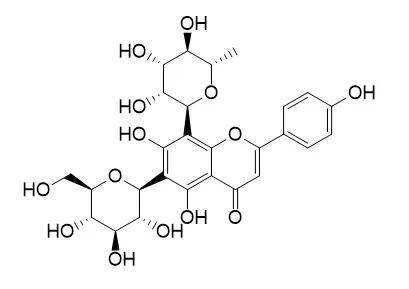| Structure Identification: |
| Zhongguo Zhong Yao Za Zhi, 2016 Jul;41(13):2481-2486 | | Separation and identification of specific components and quality standard of stem of Dendrobium officinale[Pubmed: 28905572] | | The Violanthin, a specific component, was separated and identified from the stems of Dendrobium officinale by chromatographic technique and spectroscopic method for the first time. The microscopic characteristics of D. officinale powder were examined under a microscopy and described. Thin layer chromatography (TLC) method was used for qualitative analysis of the Violanthin from D. officinale stems with a mixture of ethyl acetate, butanone, formic acid and water (4∶3∶1∶1) as the developing solvent on high performance silica gel precoated plate (SGF254) and using aluminium trichloride as a chromagenic agent. The results showed significant characteristics of Violanthin from D. officinale stems on TLC, with certain specificity, and could be used to distinguish it from other easily confusing processed medicinal stems of D. devonianum, D. gratiosissimum and D. aphyllum. The content of naringenin, an active ingredient in D. officinale stems was determined by HPLC analysis on a Bischoff Chromatography HIPAK NC-04 ODS AB column (4.4 mm×250 mm, 5 mm) with acetonitrile-0.1% phosphoric acid solution as the mobile phase for gradient elution. The wavelength was set at 226 nm and column temperature was 25 ℃. The HPLC method showed good linearity within the range of 3.90-250.00 g•mL⁻1 (r = 0.999 9) for naringenin. The average recovery of naringenin was 99.20% with 0.17% of RSD. The mass fraction of 20 batches of D. officinale stems was between 0.190 and 0.498 mg•g⁻1. The established qualitative and quantitative method was simple and rapid with good repeatability and accuracy, providing experimental basis for improving the quality standard of D. officinale, with a very important significance to ensure its quality and clinical effect. | | Chem Biodivers . 2007 Feb;4(2):139-144. | | Flavonoids and other compounds from the aerial parts of Viola etrusca[Pubmed: 17311226] | | The non-volatile constituents of the rare species Viola etrusca Erben (Violaceae), collected at Mount Amiata, Italy, were phytochemically investigated for the first time. Two new flavonoid glycosides, 4'-methoxyrhamnetin (1) and violetruscoside (2), an isorhamnetin derivative, were isolated from the flowering aerial parts, together with eleven known substances, including eight flavonoids, a phenolic acid, glycerin, and a coumarin derivative. The NMR data of Violanthin (10) and isoViolanthin (11) are reported for the first time. | | Anal Bioanal Chem . 2008 Apr;390(7):1917-1925. | | Major flavonoid components of heartsease (Viola tricolor L.) and their antioxidant activities[Pubmed: 18259733] | | Sephadex LH-20 column chromatography was used to separate flavonoid components in a heartsease methanol extract. One of the main components was identified by NMR as Violanthin (6-C-glucosyl-8-C-rhamnosylapigenin). As a first approximation, the other main flavonoid component was considered to be rutin (3-O-rhamnoglucosylquercetin), based on comprehensive comparison of retention times and UV spectra of reference molecules, as well as molecular mass and fragmentation patterns obtained by mass spectrometry. The minor flavonoids were separated by polyamide column and analyzed by LC-MS. The antioxidant capacity of different flavonoid fractions was determined using both Trolox equivalent antioxidant capacity (TEAC) and 2,2-diphenyl-1-picrylhydrazyl (DPPH) in vitro antioxidant assays. The highest electron-donor capacity was found for the major flavonoid component (rutin), whereas one minor component-rich flavonoid fraction exhibited the highest hydrogen-donor activity. |
|






 Cell. 2018 Jan 11;172(1-2):249-261.e12. doi: 10.1016/j.cell.2017.12.019.IF=36.216(2019)
Cell. 2018 Jan 11;172(1-2):249-261.e12. doi: 10.1016/j.cell.2017.12.019.IF=36.216(2019) Cell Metab. 2020 Mar 3;31(3):534-548.e5. doi: 10.1016/j.cmet.2020.01.002.IF=22.415(2019)
Cell Metab. 2020 Mar 3;31(3):534-548.e5. doi: 10.1016/j.cmet.2020.01.002.IF=22.415(2019) Mol Cell. 2017 Nov 16;68(4):673-685.e6. doi: 10.1016/j.molcel.2017.10.022.IF=14.548(2019)
Mol Cell. 2017 Nov 16;68(4):673-685.e6. doi: 10.1016/j.molcel.2017.10.022.IF=14.548(2019)